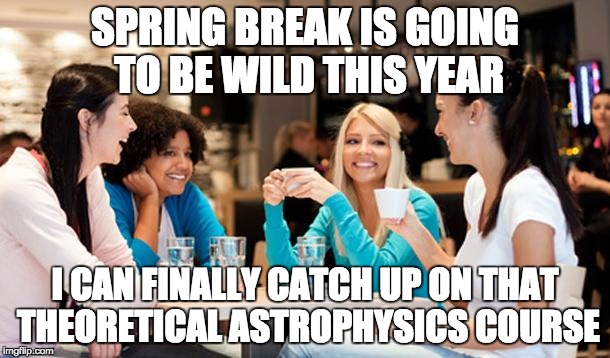Astrophysical Dynamics (AS.171.627)
Nadia Zakamska
Spring 2017
|
| This is an old course webpage for information only, not a currently active course. Some materials have been removed in preparation for the next class. |


This is a graduate course that covers the fundamentals of galaxy formation, galactic structure and stellar dynamics and includes topics in current research.
Lectures on Tuesdays at 10:30-11:45 and Thursdays at 9:00-10:15 to allow attendance at Thursday astroph coffee in Bloomberg 511.
There will be no class on Tuesday Feb 21st, Tuesday March 7th and Thursday March 9th. We will have make-up lectures on Mondays 11:00-12:15 in Bloomberg 511 on Feb 6th, Feb 27th and March 13th.
There will be no classes during Spring Break (March 20-March 26).
Rachael Alexandroff is the TA for this class.
Textbooks:
Galactic Dynamics (Binney, J., Tremaine, S.)
Optional: Galactic Astronomy (Binney, J., Merrifield, M.)
You will probably need LaTeX, python, ds9 and possibly other software.
Acknowledgments: some homework materials for this class were taken from assignments by S. Tremaine with his kind permission.

Homework assignments were posted here for the duration of the course.
Guidelines for homework:
(1) You may discuss homework with your classmates or others. You may not look at their written solutions (and thus, you may not show yours to others).
(2) You may use Internet, books, journals, and departmental resources and software. Google is an excellent place to start if there are terms and abbreviations you don't know. If you use a webpage or an article in your final solution, please provide a reference. If you use a direct quote, you must put it in quotation marks and provide a reference. Your own words are always preferable.
(3) Unless specified otherwise, there is no need to type your solutions, but we need to be able to read your handwriting.
(4) Everybody gets one free pass on one <=24 hour delay on any assignment over the entire semester. After that, partial credit is at the discretion of the TA.
The final grade is 40% homework, 20% oral presentations, 40% final exam.
Galaxy phenomenology and measurements
Jan 31. Lecture 1. Stellar systems. Galaxy morphology [BM 4.1]
Feb 2. Lecture 2. Limited sample statistics. Star / galaxy counts and luminosity function. Log N - Log S. Biases (Malmquist, Lutz-Kelker, etc.) [BM 3.6]
Feb 6. Lecture 3. V/Vmax method. Stellar luminosity function. Initial mass function. Distance ladder [BM 2.2].
Feb 7. Lecture 4. Galaxy luminosity function [BM 4.1]. Field vs
cluster galaxies. Local Group. Ultra-faint dwarfs.
Brightness and potential distribution of galaxies [BT Chapter 2]
Feb 9. Lecture 5. Surface photometry of galaxies [BM 4.2, 4.3].
Feb 14. Lecture 6. Potential theory of spherical stellar systems [BT Chapter 2]
Feb 16. Lecture 7. Potential theory of disks.
Feb 23. Lecture 8. Potential of an arbitrary density distribution. Limits of potential theory, two-body relaxation [BT 1.2, 7.1].
Stars in galaxy potential [BT Chapter 3]
Feb 27. Lecture 9. Virial theorem [BT 7.2.1]. Orbits in spherical potentials [BT 3.1].
Feb 28. Lecture 10. Integrals of motion [BT 3.1.1]. Orbits in axisymmetric potentials. Epicycle approximation [BT 3.2].
Mar 2. Lecture 11. Kinematics of stars in the solar neighborhood [BM 10.3]. Orbits in non-axisymmetric potentials [BT 3.3].
Gas in galaxy potential [BT Chapter 6]
Mar 13. Lecture 12. Gas in the Milky Way disk [BM 9.1, 9.2]. Fluid dynamics equations. Linear stability analysis, dispersion relation.
Mar 14. Snow day.
Mar 16. Lecture 13. Sound waves. Jeans instability. Stability of self-gravitating disks. Toomre Q.
Mar 20 - Mar 24: Spring break.
Mar 28. Lecture 14. Kennicutt-Schmidt law. Accretion disks. Galactic disks and spiral structure. Pattern speed. Lindblad resonances.
Mar 30. Lecture 15. Bar instability. Swing amplification.
Equilibria of collisionless systems [BT Chapter 4]
Distribution function (DF). Collisionless Boltzmann equation.
Apr 4. Lecture 16. Relationship between observables and the DF. GADGET. Jeans theorems. Ergodic DF.
Apr 6. Lecture 17. Velocity dispersion tensor (isotropic, tangentially anisotropic, radially anisotropic). Continuity equation. Jeans equation.
Apr 11. Lecture 18. Jeans equation in spherical systems. Example solutions. Isothermal sphere.
Apr 13. Lecture 19. Jeans equation in axisymmetric systems. Asymmetric drift.
Apr 18. Lecture 20. Local density of dark matter. Schwarzschild method [BT 4.7.2]. Summary of global galaxy properties: elliptical (fundamental plane), disks (Tully-Fisher).
Dissipative effects [BT Chapters 7 and 8].
Apr 20. Lecture 21. Baryons in galaxy formation (ILLUSTRIS, FIRE). Galaxy mergers. Feedback. Dynamical friction.
Apr 25. Lecture 22. Globular clusters: phenomenology, 2-body relaxation, tides, evaporation.
Apr 27. Lecture 23. Globular clusters: core collapse, gravothermal catastrophy, maximal entropy (BT 4.7), Heggie's laws, mass segregation.
Other potential topics for the class if we have time: linear growth of structure.
May 2. Lecture 24. Presentations.
May 4. Lecture 25. Presentations.
Hogg -- Distance measures in cosmology
Whittle -- Graduate extragalactic astronomy
Latex template, style file and instructions
Garland -- Advice for beginning physics speakers
Lisa Randall about Vera Rubin



